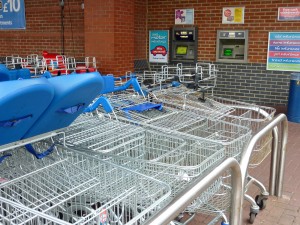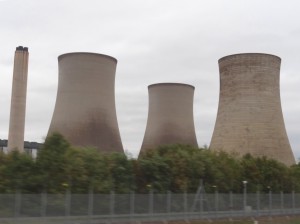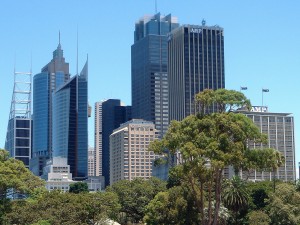 In oligopoly markets, because there are a small number of firms, each firm is affected by its rivals’ decisions. This interdependence results in a tension between cooperation and competition. On the one hand, firms collectively benefit from cooperating and keeping prices high.
In oligopoly markets, because there are a small number of firms, each firm is affected by its rivals’ decisions. This interdependence results in a tension between cooperation and competition. On the one hand, firms collectively benefit from cooperating and keeping prices high.
On the other hand, an individual firm then has an incentive to undercut its rivals to steal a larger share of the market. This incentive to undercut can potentially result in price wars between firms. This is exactly what has recently occurred between pizza sellers on the Avenue of Americas in Midtown New York. Here, until recently the 6th Ave. Pizza company was selling pizza for $1.50 per slice. However, the entry of two competitors nearby sparked an intense and bitter price war.
First, an outlet called Joey Pepperoni’s Pizza opened nearby and charged $1 per slice. This price was then matched by the 6th Avenue Pizza company. Then, the 2 Bros. pizza chain opened an outlet almost next door to the 6th Avenue Pizza company. Initially, they also charged $1 per slice.
 However, this did not last for too long. First 6th Avenue cut its price to 79 cents and then 2 Bros. responded by cutting its price to 75 cents, which 6th Avenue quickly matched.
However, this did not last for too long. First 6th Avenue cut its price to 79 cents and then 2 Bros. responded by cutting its price to 75 cents, which 6th Avenue quickly matched.
Which company started this price war has been subject to some debate. The owners of the 6th Avenue Pizza company were angry, alleging that 2 Bros. was trying to force them out of business. However, the owners of 2 Bros. claimed that they were simply responding to the 6th Avenue Pizza company’s decision to start charging 79 cents per slice and they even have evidence from their security cameras confirming this! When asked why they cut their price the owners of the 6th Avenue company said that:
He was taking away our customers. How were we going to pay our rent?
So what will happen next in this market? One of the owners of the 2 Bros. company has said that they will go back to $1 per slice if the 6th Avenue Pizza company does the same, as they can’t make any profit at the current price. However, the tension between cooperation and competition suggests this may be difficult to sustain.
In the meantime, both are quoted suggesting that they may be tempted to reduce prices even further. 6th Avenue Pizza company stated:
We may go to 50 cents. I want to hit him. I want to beat him.
2 Bros. said:
We might go to free pizza soon.
Of course, while the price war continues, the clear winners are the consumers. In the article one is quoted as saying:
I think it’s beautiful. We need 75-cent hamburgers next.
Articles
Questions
- Why is it difficult for firms to maintain high prices in oligopolistic markets?
- What are the key features of competition in the pizza market?
- Is this the type of market where you would expect price wars to be likely?
- How might firms in this market try to differentiate their product?
- Do you think prices will ever return to $1.50 per slice in this market? Explain.
 After weak Christmas trading, Tesco issued a profit warning – its first in 20 years. Following this, their shares fell in value by some £5bn, but this was met with an announcement of the creation of 20,000 jobs in the coming years, as part of a project to train staff, improve existing stores and open new ones. Yet, Tesco has reported another quarter of falling sales.
After weak Christmas trading, Tesco issued a profit warning – its first in 20 years. Following this, their shares fell in value by some £5bn, but this was met with an announcement of the creation of 20,000 jobs in the coming years, as part of a project to train staff, improve existing stores and open new ones. Yet, Tesco has reported another quarter of falling sales.
Trading times have been challenging and the fact that the UK’s biggest supermarket is struggling is only further evidence to support this. In the 13 weeks to the 26th May 2012, Tesco reported a decline in like-for-like sales of 1.5%. Although much of the £1bn investment in Tesco is yet to be spent, the fact that sales have fallen for a full year must be of concern, not only to its Chief Executive, but also to analysts considering the economic future for the UK.
Consumer confidence remains low and together with tight budgets, shoppers are continuing to be very cautious of any unnecessary spending. Part of Tesco’s recent drive to drum up sales has been better customer service and a continuing promotion war with the other supermarkets. This particular sector is highly competitive and money-off coupons and other such promotions plays a huge part in the competitive process. Whilst low prices are obviously crucial, this is one sector where non-price competition can be just as important.
Although Tesco sales in the UK have been nothing to shout about – the Chief Executive said their sales performance was ‘steady’ – its total global sales did increase by 2.2%. The Chief Executive, Mr Clarke said:
‘Internationally, like-for-like sales growth proved resilient, despite slowing economic growth in China…Against the backdrop of continued uncertainty in the eurozone, it is pleasing to see that our businesses have largely sustained their performance.’
A boost for UK sales did come with the Jubilee weekend and with the Olympics just round the corner, Tesco will be hoping for a stronger end to the year than their beginning. The following articles consider Tesco’s sales and the relative performance of the rest of the sector.
Tesco’s quarterly sales hit by ‘challenging’ trading BBC News (11/6/12)
Tesco UK arm notches up one year of falling sales Guardian, Zoe Wood (11/6/12)
Tesco upbeat despite new sales dip Independent, Peter Cripps (11/6/12)
Tesco sales seen lower in first quarter Reuters, James Davey(11/6/12)
The Week Ahead: Tesco set to admit it is losing ground to rivals Independent, Toby Green (11/6/12)
Tesco’s performance in the UK forecast to slip again Telegraph, Harry Wallop (10/6/12)
Tesco: What the analysts say Retail Week, Alex Lawson (11/6/12)
Supermarkets issue trading updates The Press Association (9/6/12)
The Week Ahead: Supermarkets prepare to give City food for thought Scotsman, Martin Flanagan (11/6/12)
Asda’s sales growth accelerates Reuters, James Davey (17/5/12)
Asda sales increase helped by Tesco Telegraph, Harry Wallop (18/5/12)
Tesco v. Sainsbury’s in trading update battle Manchester Evening News (11/6/12)
Sainsbury’s out-trades Tesco on UK food sales Independent, James Thompson (10/6/12)
Questions
- Using some examples, explain what is meant by non-price competition.
- Why has Tesco been losing ground to its competitors?
- Given the products that Tesco sells (largely necessities), why have sales been falling, despite household’s tight budgets?
- Into which market structure would you place the supermarket sector? Explain your answer by considering each of the assumptions behind the market structure you choose.
- Why have Tesco’s rivals been gaining ground on Tesco?
- How might this latest sales data affect Tesco’s share prices?
- Based on what the analysts are saying about the food sector, can we deduce anything about the future of the UK economy in the coming months?
 Centrica, owners of British Gas, has warned that electricity and gas prices in the UK are set to rise in the autumn. Centrica blames this on the expected rise in the costs of wholesale gas and other non-energy inputs.
Centrica, owners of British Gas, has warned that electricity and gas prices in the UK are set to rise in the autumn. Centrica blames this on the expected rise in the costs of wholesale gas and other non-energy inputs.
One of the other ‘big six’ energy suppliers, E.On, has responded by saying that it will not raise energy prices this year. Whether it will raise prices after 1 Jan next year remains to be seen.
Last autumn, household energy prices rose substantially: between 15.4% and 18% for gas and between 4.5% and 16% for electricity. This spring, in response to lower wholesale energy prices, suppliers cut prices for either electricity or gas (but not both) by around 5%.
The government and various pressure groups are encouraging consumers to use price comparison sites to switch to a cheaper supplier. The problem with this is that supplier A may be cheaper than supplier B one month, but B cheaper than A the next. Nevertheless, switching does impose some degree of additional competitive pressure on suppliers.
More powerful pressure could be applied by ‘collective switching’. This is where a lot of people switch via an intermediary company, which sources a deal from an energy supplier. This collective buying is a form of countervailing power to offset the oligopoly power of the suppliers. Such schemes are being encouraged by the Energy Minister, Ed Davey.
The other approach, apart from doing nothing, is for Ofgem, the energy regulator, to impose tough conditions on pricing. But at present, Ofgem’s approach has been to try to make the market more competitive (see also), rather than regulating prices.
British Gas owner Centrica warns of higher energy bills BBC News (11/5/12)
E.ON to keep residential energy prices unchanged in 2012 Reuters, Adveith Nair (14/5/12)
E.ON promises to hold energy prices for 5million customers in 2012 This is Money, Tara Evans (14/5/12)
British Gas owner Centrica feels cold blast from critics ShareCast, John Harrington (11/5/12)
Gas and electricity price battle lines drawn BBC News (14/5/12)
Taking on the energy giants: The co-operative insurgency gains ground Left Foot Forward, Daniel Elton (11/5/12)
Group Energy Buying hits the UK Headlines Spend Matters UK/Europe, Peter Smith (11/5/12)
Think tank calls for competition to break Big Six rip-off Energy Live News, Tom Gibson (30/4/12)
Collective switching will not fix the UK’s broken energy market Guardian, Reg Platt (27/4/12)
Make your own small switch for cheaper energy The Telegraph, Rosie Murray-West (14/5/12)
Questions
- What are the barriers to entry in the electricity supply market?
- How competitive is the retail energy market at present?
- To what extent do price comparison sites put pressure on energy companies to reeduce prices or limit price increases?
- What scope is there for collective buying of gas and electricity from the six energy suppliers by (a) households; (b) firms?
- Assess Ofgem’s package of proposals for a simpler and more competitive energy market.
 Oligopoly: it’s a complex market structure and although closer to the monopoly end of the ‘Market Structure Spectrum’, it can still be a highly competitive market. The characteristics are well-documented and key to the degree of competition within any oligopoly is the number of competitors and extent to which there are barriers to entry.
Oligopoly: it’s a complex market structure and although closer to the monopoly end of the ‘Market Structure Spectrum’, it can still be a highly competitive market. The characteristics are well-documented and key to the degree of competition within any oligopoly is the number of competitors and extent to which there are barriers to entry.
The greater the barriers and the fewer the competitors the greater the power the established firms have. This can then spell trouble for pricing and hence for consumers. The following articles are just some examples of the oligopolies that exist around the world and some of the benefits and problems that accompany them.
Articles
Oligopoly of PSU oil cos reason for high ATF prices The Indian Express, Smita Aggarwal (30/4/12)
Group energy buying hits the UK headlines Spend Matters UK/Europe(18/1/11)
German cartel office probes petrol companies on pricing Fox Business (4/4/12)
Gov’t unveils steps to lower fuel prices Yonhap News (19/4/12)
How big banks threaten our economy Wall Street Journal, Warren Stephens (29/4/12)
UK Governance: Call for Whitehall to simplify the landscape for SME suppliers to win more government contracts The Information Daily (26/4/12)
Other blogs
Pumping up the price: fuel cartels in Germany April 2012
Energy profit margins up by over 700% October 2011
Every basket helps October 2011
The art of oligopoly December 2010
Questions
- What are the assumptions of an oligopolistic market structure?
- Consider (a) the energy sector and (b) the banking sector. To what extent does each market conform with the assumptions of an oligopoly?
- In the ‘Spend Matters’ article, a group of people in a Lincolnshire village formed a local buying consortium to negotiate deals for heating oil. What could we refer to this as?
- To what extent is an oligopoly in the public interest?
- Explain how barriers to entry in oligopolies affect the competitiveness and efficiency of a market.
- Illustrate how an oligopolistic market structure can fix prices and hence exploit consumers.
- How have the actions of the big oil companies in both the UK and Germany been against independent retailers and the consumer interest?
- What action can governments take to break up oligopolies? Will it always be effective?
 Fuel prices at German petrol stations fluctuate wildly – by up to €0.14 per day. They are also often changed several times per day. In morning rush hours, when demand is less elastic, prices may shoot up, only to drop again once people are at work.
Fuel prices at German petrol stations fluctuate wildly – by up to €0.14 per day. They are also often changed several times per day. In morning rush hours, when demand is less elastic, prices may shoot up, only to drop again once people are at work.
But is this a sign of healthy competition? Critics claim the opposite: that it’s a sign of the oligopoly power of the oil companies. More than two-thirds of Germany’s petrol stations are franchises of five big oil companies: BP/Aral, Esso, Jet, Shell and Total. These five companies directly control the prices at the pumps. According to the Der Spiegel article below, oil companies:
have sophisticated computer systems that allow them to precisely control, right down to the minute, when they increase their prices nationwide, and by how many cents. The prices are not set by the individual franchise holders. Instead, they are centrally controlled – for example, in the town of Bochum, at the headquarters of Aral, a BP subsidiary that is the market leader in Germany.
The price manager merely presses a button and price signs immediately change at all 2,391 Aral service stations in Germany. All filling stations are electronically linked with Bochum via a dedicated network called Rosi. After each price increase, they watch closely to see how the competition reacts and whether they follow suit.
… If the competitor’s prices are significantly cheaper, the Aral franchise holder can, with the help of Rosi, apply for permission to reduce the prices again.
Not only do the oil companies control the prices at the pumps, but they observe closely, via their franchise holders, the actions of their rivals, and then respond in ways which critics claim is collusive rather than competitive. The problem has become worse with the introduction of incentives to the franchise owners of additional commission if they exceed the price of their competitors within the local area. This has the effect of ratcheting prices up.
The sophisticated pricing strategies, with prices adjusted frequently according to price elasticity of demand, are making it very hard for independent operators to compete.
In response, the German Cartel Office has launched an investigation into the oil companies and in particular into the issues of collusion and frequent price changes and how these impact on independent operators.
German anti-trust authority probes alleged fuel cartel Deutsche Welle (4/4/12)
German antitrust watchdog to probe oil majors-paper Reuters, Ludwig Burger (3/4/12)
Oil giants probed over claims they rigged petrol prices in Germany The Telegraph, Nathalie Thomas (4/4/12)
BP, Exxon, Esso, Jet, Shell and Total in Germany Price Fix Probe International Business Times (9/4/12)
German cartel office probes petrol company pricing MarketWatch (4/4/12)
Kartellverfahren gegen fünf Mineralölkonzerne (in German) Frankfurter Allgemeine Zeitung, Helmut Bünder and Manfred Schäfers (4/4/12)
Crazy gas prices driving German consumers mad msnbc, Andy Eckardt (3/4/12)
Big Oil’s Strategy for Jacking Up Gas Prices Der Spiegel, Alexander Jung and Alexander Neubacher (5/4/12)
Questions
- What the features of the German road fuel oligopoly?
- Why does the price elasticity of demand for petrol and diesel vary with the time of day? Is it likely to vary from one week to another and, if so, why?
- In what ways have the actions of the big five oil companies been against the interests of the independent petrol station operators?
- Consider the alternatives open to the German Federal Cartel Office for making the market more competitive.
- Would it be a good idea for the big five German companies to be forced to adopt the Western Australian system of price changes?
 In oligopoly markets, because there are a small number of firms, each firm is affected by its rivals’ decisions. This interdependence results in a tension between cooperation and competition. On the one hand, firms collectively benefit from cooperating and keeping prices high.
In oligopoly markets, because there are a small number of firms, each firm is affected by its rivals’ decisions. This interdependence results in a tension between cooperation and competition. On the one hand, firms collectively benefit from cooperating and keeping prices high. However, this did not last for too long. First 6th Avenue cut its price to 79 cents and then 2 Bros. responded by cutting its price to 75 cents, which 6th Avenue quickly matched.
However, this did not last for too long. First 6th Avenue cut its price to 79 cents and then 2 Bros. responded by cutting its price to 75 cents, which 6th Avenue quickly matched.


